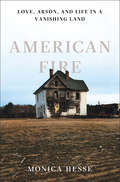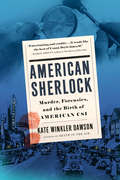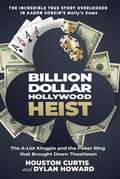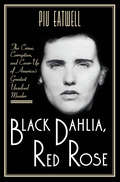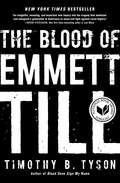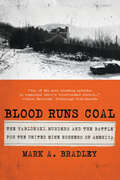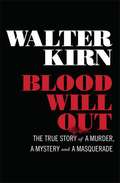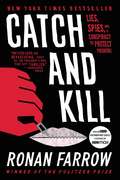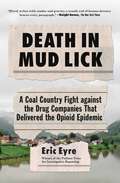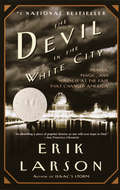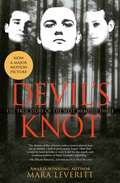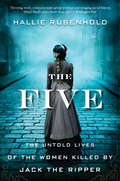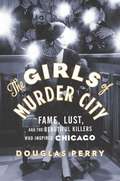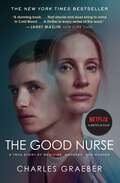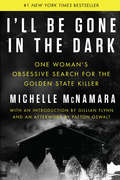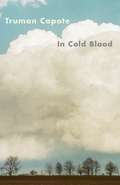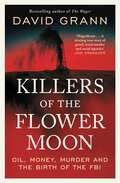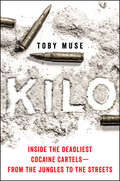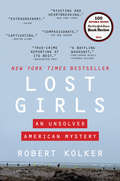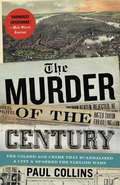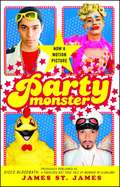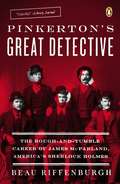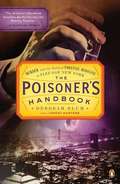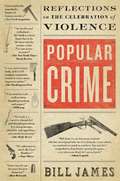Special Collections
True Crime Books
Description: Read all about the darkest parts of our crime obsession: the real stories. #adults
- Table View
- List View
American Fire
by Monica HesseThe arsons started on a cold November midnight and didn’t stop for months. Night after night, the people of Accomack County waited to see which building would burn down next, regarding each other at first with compassion, and later suspicion. Vigilante groups sprang up, patrolling the rural Virginia coast with cameras and camouflage. Volunteer firefighters slept at their stations. The arsonist seemed to target abandoned buildings, but local police were stretched too thin to surveil them all. Accomack was desolate—there were hundreds of abandoned buildings. And by the dozen they were burning.
American Sherlock
by Kate Winkler DawsonFrom the acclaimed author of Death in the Air ("Not since Devil in the White City has a book told such a harrowing tale"--Douglas Preston) comes the riveting story of the birth of criminal investigation in the twentieth century.Berkeley, California, 1933. In a lab filled with curiosities--beakers, microscopes, Bunsen burners, and hundreds upon hundreds of books--sat an investigator who would go on to crack at least two thousand cases in his forty-year career. Known as the "American Sherlock Holmes," Edward Oscar Heinrich was one of America's greatest--and first--forensic scientists, with an uncanny knack for finding clues, establishing evidence, and deducing answers with a skill that seemed almost supernatural.Heinrich was one of the nation's first expert witnesses, working in a time when the turmoil of Prohibition led to sensationalized crime reporting and only a small, systematic study of evidence. However with his brilliance, and commanding presence in both the courtroom and at crime scenes, Heinrich spearheaded the invention of a myriad of new forensic tools that police still use today, including blood spatter analysis, ballistics, lie-detector tests, and the use of fingerprints as courtroom evidence. His work, though not without its serious--some would say fatal--flaws, changed the course of American criminal investigation. Based on years of research and thousands of never-before-published primary source materials, American Sherlock captures the life of the man who pioneered the science our legal system now relies upon--as well as the limits of those techniques and the very human experts who wield them.
Billion Dollar Hollywood Heist
by Dylan Howard and Houston Curtis&“Right out of the gate, the entire game was designed to empty the pockets of those rich, celeb-loving LA suckers.&”—Houston Curtis Leonardo DiCaprio. Alex Rodriguez. Tobey Maguire. Ben Affleck. Matt Damon. John Cassavetes. What do these people have in common? Not just fame and fortune; all these men are also alumni of the ultra-exclusive, high-stakes poker ring that inspired Aaron Sorkin&’s Oscar-nominated film, Molly&’s Game. But Houston Curtis, the card shark who co-founded the game with Tobey Maguire, knows that Sorkin&’s is the whitewashed version. In Billion Dollar Hollywood Heist, Curtis goes all-in, revealing the true story behind the game. From its origins with Maguire to staking DiCaprio&’s first game, installing Molly Bloom, avoiding the hookers and blow down the hall, and weathering the FBI investigation that left Curtis with a lien on his house, this is the no-holds-barred account of the world&’s most exclusive Texas Hold &’Em game from the man who started it—with all the names and salacious details that Molly&’s Game left out. With the insider appeal of Rounders, more A-listers than Ocean&’s 11, and the excitement of The Sting, Billion Dollar Hollywood Heist is the untold, insider&’s story that makes Molly&’s Game look tame.
Black Dahlia, Red Rose
by Piu EatwellWith startling new evidence, this gripping reexamination of the Black Dahlia murder offers a definitive theory of a quintessential American crime.
Los Angeles, 1947. A housewife out for a walk with her baby notices a cloud of black flies buzzing ominously in Leimert Park. An "unsightly object" is identified as the mutilated body of Elizabeth Short, an aspiring starlet from Massachusetts who had been lured west by the siren call of Hollywood. Her killer would never be found, but Short’s death would bring her the fame she had always sought. Her murder investigation transformed into a real-life film noir, featuring corrupt cops, femmes fatales, gun-slinging gangsters, and hungry reporters, replete with an irresistible, legendary moniker adapted from a recent film—The Black Dahlia.
For over half a century this crime has maintained an almost mythic place in American lore as one of our most inscrutable cold cases. With the recently unredacted FBI file, newly released sections of the LAPD file, and exclusive interviews with the suspect’s family, relentless legal sleuth Piu Eatwell has gained unprecedented access to evidence and persuasively identified the culprit. Black Dahlia, Red Rose layers these findings into a gritty, cinematic retelling of the haunting tale.
As Eatwell chronicles, among the first to arrive at the grisly crime scene was Aggie Underwood, the "tough-as-nails" city editor for the Los Angeles Evening Herald & Express; meanwhile, the chain-smoking city editor for the Los Angeles Examiner, Jimmy Richardson, sent out his own reporters. Eatwell reveals how, through a cutthroat race to break news and sell papers, the public image of Elizabeth Short was distorted from a violated beauty to a "man crazy delinquent." As rumors of various boyfriends circulated, the true story of the complex young woman ricocheting between jobs, lovers, and homes was lost. Instead, kitschy headlines tapped into a wider social anxiety about the city’s "girl problem," and Short’s black chiffon and smoldering gaze become a warning for "loose" women coming of age in postwar America.
Applying her own background as a lawyer to the surprising new evidence, Eatwell ultimately exposes many startling clues to the case that have never surfaced in public. From the discovery of Elizabeth’s notebook, inscribed with the name of the city’s most notorious and corrupt businessman, to a valid suspect plucked from the hundreds of "confessing Sams" by a brilliant, well-meaning doctor, Eatwell compellingly captures every "big break" in the police investigation to reveal a truly viable resolution to the case. In rich, atmospheric prose, Eatwell separates fact from fantasy to expose the truth behind the sinewy networks of a noir-tinged Hollywood. Black Dahlia, Red Rose at long last accords the Elizabeth Short case its due resolution, providing a reliable and enduring account of one of the most notorious unsolved murders in American history.
The Blood of Emmett Till
by Timothy B. TysonThis extraordinary New York Times bestseller reexamines a pivotal event of the civil rights movement—the 1955 lynching of Emmett Till—&“and demands that we do the one vital thing we aren&’t often enough asked to do with history: learn from it&” (The Atlantic). * A New York Times Notable Book * A Washington Post Notable Book * Longlisted for the National Book Award * Winner of the Robert F. Kennedy Book Award *An NPR, Los Angeles Times, and Atlanta Journal-Constitution Best Book of the Year *In 1955, white men in the Mississippi Delta lynched a fourteen-year-old from Chicago named Emmett Till. His murder was part of a wave of white terrorism in the wake of the 1954 Supreme Court decision that declared public school segregation unconstitutional. Only weeks later, Rosa Parks thought about young Emmett as she refused to move to the back of a city bus in Montgomery, Alabama. Five years later, Black students who called themselves &“the Emmett Till generation&” launched sit-in campaigns that turned the struggle for civil rights into a mass movement. Till&’s lynching became the most notorious hate crime in American history. But what actually happened to Emmett Till—not the icon of injustice, but the flesh-and-blood boy? Part detective story, part political history, The Blood of Emmett Till &“unfolds like a movie&” (The Atlanta Journal-Constitution), drawing on a wealth of new evidence, including a shocking admission of Till&’s innocence from the woman in whose name he was killed. &“Jolting and powerful&” (The Washington Post), the book &“provides fresh insight into the way race has informed and deformed our democratic institutions&” (Diane McWhorter, Pulitzer Prize–winning author of Carry Me Home) and &“calls us to the cause of justice today&” (Rev. Dr. William J. Barber, II, president of the North Carolina NAACP).
Blood Runs Coal
by Mark A. BradleyA vivid account of “one of the most shocking episodes in organized labor’s blood-soaked history” (Steve Halvonik, Pittsburgh Post-Gazette). In the early hours of New Year’s Eve 1969, in the small soft coal mining borough of Clarksville, Pennsylvania, longtime trade union insider Joseph “Jock” Yablonski and his wife and daughter were brutally murdered in their old stone farmhouse. Behind the assassination was the corrupt president of the United Mine Workers of America (UMWA), Tony Boyle, who had long embezzled UMWA funds, silenced intra-union dissent, and served the interests of Big Coal companies—and would do anything to maintain power. The most infamous crimes in the history of American labor unions, the Yablonski murders catalyzed the first successful rank-and-file takeover of a major labor union in modern US history. Blood Runs Coal is an extraordinary portrait of one of the nation’s major unions on the brink of historical change.
Blood Will Out
by Walter KirnIn the summer of 1998, Walter Kirn--then an aspiring novelist struggling with impending fatherhood and a dissolving marriage--set out on a peculiar, fateful errand: to personally deliver a crippled hunting dog from his home in Montana to the New York apartment of one Clark Rockefeller, a secretive young banker and art collector who had adopted the dog over the Internet.
Thus began a fifteen-year relationship that drew Kirn deep into the fun-house world of an outlandish, eccentric son of privilege who ultimately would be unmasked as a brazen serial impostor, child kidnapper, and brutal murderer. Kirn's one-of-a-kind story of being duped by a real-life Mr. Ripley takes us on a bizarre and haunting journey from the posh private clubrooms of Manhattan to the hard-boiled courtrooms and prisons of Los Angeles. As Kirn uncovers the truth about his friend, a psychopath masquerading as a gentleman, he also confronts hard truths about himself. Why, as a writer of fiction, was he susceptible to the deception of a sinister fantasist whose crimes, Kirn learns, were based on books and movies? What are the hidden psychological links between the artist and the con man? To answer these and other questions, Kirn attends his old friend's murder trial and uses it as an occasion to reflect on both their tangled personal relationship and the surprising literary sources of Rockefeller's evil.
This investigation of the past climaxes in a tense jailhouse reunion with a man whom Kirn realizes he barely knew--a predatory, sophisticated genius whose life, in some respects, parallels his own and who may have intended to take another victim during his years as a fugitive from justice: Kirn himself. Combining confessional memoir, true crime reporting, and cultural speculation, Blood Will Out is a Dreiseresque tale of self-invention, upward mobility, and intellectual arrogance. It exposes the layers of longing and corruption, ambition and self-delusion beneath the Great American con.
Catch and Kill
by Ronan FarrowIn a dramatic account of violence and espionage, Pulitzer Prize-winning investigative reporter Ronan Farrow exposes serial abusers and a cabal of powerful interests hell-bent on covering up the truth, at any cost.
In 2017, a routine network television investigation led Ronan Farrow to a story only whispered about: one of Hollywood's most powerful producers was a predator, protected by fear, wealth, and a conspiracy of silence. As Farrow drew closer to the truth, shadowy operatives, from high-priced lawyers to elite war-hardened spies, mounted a secret campaign of intimidation, threatening his career, following his every move, and weaponizing an account of abuse in his own family.
All the while, Farrow and his producer faced a degree of resistance they could not explain -- until now. And a trail of clues revealed corruption and cover-ups from Hollywood to Washington and beyond.
This is the untold story of the exotic tactics of surveillance and intimidation deployed by wealthy and connected men to threaten journalists, evade accountability, and silence victims of abuse. And it's the story of the women who risked everything to expose the truth and spark a global movement.Both a spy thriller and a meticulous work of investigative journalism, Catch and Kill breaks devastating new stories about the rampant abuse of power and sheds far-reaching light on investigations that shook our culture.
A New York Times Bestseller
Death in Mud Lick
by Eric EyreFrom a Pulitzer Prize–winning reporter from the smallest newspaper ever to win the prize in the investigative reporting category, an urgent, riveting, and heartbreaking investigation into the corporate greed that pumped millions of pain pills into small Appalachian towns, decimating communities.
Death in Mud Lick is the story of a pharmacy in Kermit, West Virginia, that distributed 12 million opioid pain pills in three years to a town with a population of 382 people—and of one woman, desperate for justice, after losing her brother to overdose. Debbie Preece’s fight for accountability for her brother’s death took her well beyond the Sav-Rite Pharmacy in coal country, ultimately leading to three of the biggest drug wholesalers in the country. She was joined by a crusading lawyer and by local journalist, Eric Eyre, who uncovered a massive opioid pill-dumping scandal that shook the foundation of America’s largest drug companies—and won him a Pulitzer Prize.
Part Erin Brockovich, part Spotlight, Death in Mud Lick details the clandestine meetings with whistleblowers; a court fight to unseal filings that the drug distributors tried to keep hidden, a push to secure the DEA pill-shipment data, and the fallout after Eyre’s local paper, the Gazette-Mail, the smallest newspaper ever to win a Pulitzer Prize for investigative reporting, broke the story. Eyre follows the opioid shipments into individual counties, pharmacies, and homes in West Virginia and explains how thousands of Appalachians got hooked on prescription drugs—resulting in the highest overdose rates in the country.
But despite the tragedy, there is also hope as citizens banded together to create positive change—and won. A work of deep reporting and personal conviction, Eric Eyre’s intimate portrayal of a national public health crisis illuminates the shocking pattern of corporate greed and its repercussions for the citizens of West Virginia—and the nation—to this day.
The Devil in the White City
by Erik Larson#1 NATIONAL BESTSELLER • NATIONAL BOOK AWARD FINALIST • From the #1 New York Times bestselling author of The Splendid and the Vile comes the true tale of the 1893 World's Fair in Chicago and the cunning serial killer who used the magic and majesty of the fair to lure his victims to their death. &“As absorbing a piece of popular history as one will ever hope to find.&” —San Francisco ChronicleCombining meticulous research with nail-biting storytelling, Erik Larson has crafted a narrative with all the wonder of newly discovered history and the thrills of the best fiction.Two men, each handsome and unusually adept at his chosen work, embodied an element of the great dynamic that characterized America&’s rush toward the twentieth century. The architect was Daniel Hudson Burnham, the fair&’s brilliant director of works and the builder of many of the country&’s most important structures, including the Flatiron Building in New York and Union Station in Washington, D.C. The murderer was Henry H. Holmes, a young doctor who, in a malign parody of the White City, built his &“World&’s Fair Hotel&” just west of the fairgrounds—a torture palace complete with dissection table, gas chamber, and 3,000-degree crematorium. Burnham overcame tremendous obstacles and tragedies as he organized the talents of Frederick Law Olmsted, Charles McKim, Louis Sullivan, and others to transform swampy Jackson Park into the White City, while Holmes used the attraction of the great fair and his own satanic charms to lure scores of young women to their deaths. What makes the story all the more chilling is that Holmes really lived, walking the grounds of that dream city by the lake.The Devil in the White City draws the reader into the enchantment of the Guilded Age, made all the more appealing by a supporting cast of real-life characters, including Buffalo Bill, Theodore Dreiser, Susan B. Anthony, Thomas Edison, Archduke Francis Ferdinand, and others. Erik Larson&’s gifts as a storyteller are magnificently displayed in this rich narrative of the master builder, the killer, and the great fair that obsessed them both.
Devil's Knot
by Mara Leveritt*SOON TO BE A MAJOR MOTION PICTURE STARRING REESE WITHERSPOON AND COLIN FIRTH * The West Memphis Three. Accused, convicted...and set free. Do you know their story?In 2011, one of the greatest miscarriages of justice in American legal history was set right when Damien Echols, Jason Baldwin, and Jessie Misskelley were released after eighteen years in prison. Award-winning journalist Mara Leveritt's The Devil's Knot remains the most comprehensive, insightful reporting ever done on the investigation, trials, and convictions of three teenage boys who became known as the West Memphis Three. For weeks in 1993, after the murders of three eight-year-old boys, police in West Memphis, Arkansas seemed stymied. Then suddenly, detectives charged three teenagers--alleged members of a satanic cult--with the killings. Despite the witch-hunt atmosphere of the trials, and a case which included stunning investigative blunders, a confession riddled with errors, and an absence of physical evidence linking any of the accused to the crime, the teenagers were convicted. Jurors sentenced Jason Baldwin and Jessie Misskelley to life in prison and Damien Echols, the accused ringleader, to death. The guilty verdicts were popular in their home state--even upheld on appeal--and all three remained in prison until their unprecedented release in August 2011.With close-up views of its key participants, this award-winning account unravels the many tangled knots of this endlessly shocking case, one which will shape the American legal landscape for years to come.
The Evidence of Things Not Seen
by James BaldwinIn his searing and moving essay, James Baldwin explores the Atlanta child murders that took place over a period of twenty-two months in 1979 and 1980. Examining this incident with a reporter's skill and an essayist's insight, he notes the significance of Atlanta as the site of these brutal killings a city that claimed to be too busy to hate and the permeation of race throughout the case: the black administration in Atlanta; the murdered black children; and Wayne Williams, the black man tried for the crimes. Rummaging through the ruins of American race relations, Baldwin addresses all the hard-to-face issues that have brought us a moment in history where it is terrifying to to be a black child in white America, and where, too often, public officials fail to ask real questions about justice for all. Baldwin takes a time-specific event and makes it timeless: The Evidence of Things Not Seen offers an incisive look at race in America through a lens at once disturbing and profoundly revealing.
The Five
by Hallie RubenholdFive devastating human stories and a dark and moving portrait of Victorian London—the untold lives of the women killed by Jack the Ripper. Polly, Annie, Elizabeth, Catherine and Mary-Jane are famous for the same thing, though they never met. They came from Fleet Street, Knightsbridge, Wolverhampton, Sweden, and Wales. They wrote ballads, ran coffee houses, lived on country estates, they breathed ink-dust from printing presses and escaped people-traffickers. What they had in common was the year of their murders: 1888. The person responsible was never identified, but the character created by the press to fill that gap has become far more famous than any of these five women. For more than a century, newspapers have been keen to tell us that "the Ripper" preyed on prostitutes. Not only is this untrue, as historian Hallie Rubenhold has discovered, it has prevented the real stories of these fascinating women from being told. Now, in this devastating narrative of five lives, Rubenhold finally sets the record straight, revealing a world not just of Dickens and Queen Victoria, but of poverty, homelessness and rampant misogyny. They died because they were in the wrong place at the wrong time—but their greatest misfortune was to be born a woman.
The Girls of Murder City
by Douglas PerryThe true story of the murderesses who became media sensations and inspired the musical Chicago Chicago, 1924. There was nothing surprising about men turning up dead in the Second City. Life was cheaper than a quart of illicit gin in the gangland capital of the world. But two murders that spring were special - worthy of celebration. So believed Maurine Watkins, a wanna-be playwright and a "girl reporter" for the Chicago Tribune, the city's "hanging paper. "
Newspaperwomen were supposed to write about clubs, cooking and clothes, but the intrepid Miss Watkins, a minister's daughter from a small town, zeroed in on murderers instead. Looking for subjects to turn into a play, she would make "Stylish Belva" Gaertner and "Beautiful Beulah" Annan - both of whom had brazenly shot down their lovers - the talk of the town. Love-struck men sent flowers to the jail and newly emancipated women sent impassioned letters to the newspapers. Soon more than a dozen women preened and strutted on "Murderesses' Row" as they awaited trial, desperate for the same attention that was being lavished on Maurine Watkins's favorites.
In the tradition of Erik Larson's The Devil in the White City and Karen Abbott's Sin in the Second City, Douglas Perry vividly captures Jazz Age Chicago and the sensationalized circus atmosphere that gave rise to the concept of the celebrity criminal. Fueled by rich period detail and enlivened by a cast of characters who seemed destined for the stage, The Girls of Murder City is crackling social history that simultaneously presents the freewheeling spirit of the age and its sober repercussions.
The Good Nurse
by Charles GraeberAfter his December 2003 arrest, registered nurse Charlie Cullen was quickly dubbed "The Angel of Death" by the media. But Cullen was no mercy killer, nor was he a simple monster. He was a favorite son, husband, beloved father, best friend, and celebrated caregiver. Implicated in the deaths of as many as 300 patients, he was also perhaps the most prolific serial killer in American history. Cullen's murderous career in the world's most trusted profession spanned sixteen years and nine hospitals across New Jersey and Pennsylvania. When, in March of 2006, Charles Cullen was marched from his final sentencing in an Allentown, Pennsylvania, courthouse into a waiting police van, it seemed certain that the chilling secrets of his life, career, and capture would disappear with him.
Now, in a riveting piece of investigative journalism nearly ten years in the making, journalist Charles Graeber presents the whole story for the first time. Based on hundreds of pages of previously unseen police records, interviews, wire-tap recordings and videotapes, as well as exclusive jailhouse conversations with Cullen himself and the confidential informant who helped bring him down, THE GOOD NURSE weaves an urgent, terrifying tale of murder, friendship, and betrayal. Graeber's portrait of Cullen depicts a surprisingly intelligent and complicated young man whose promising career was overwhelmed by his compulsion to kill, and whose shy demeanor masked a twisted interior life hidden even to his family and friends.
Were it not for the hardboiled, unrelenting work of two former Newark homicide detectives racing to put together the pieces of Cullen's professional past, and a fellow nurse willing to put everything at risk, including her job and the safety of her children, there's no telling how many more lives could have been lost. In the tradition of In Cold Blood, THE GOOD NURSE does more than chronicle Cullen's deadly career and the breathless efforts to stop him; it paints an incredibly vivid portrait of madness and offers a penetrating look inside America's medical system. Harrowing and irresistibly paced, this book will make you look at medicine, hospitals, and the people who work in them, in an entirely different way.
I'll Be Gone in the Dark
by Gillian Flynn and Patton Oswalt and Michelle McNamaraA masterful true crime account of the Golden State Killer—the elusive serial rapist turned murderer who terrorized California for over a decade—from Michelle McNamara, the gifted journalist who died tragically while investigating the case. For more than ten years, a mysterious and violent predator committed fifty sexual assaults in Northern California before moving south, where he perpetrated ten sadistic murders. Then he disappeared, eluding capture by multiple police forces and some of the best detectives in the area.
Three decades later, Michelle McNamara, a true crime journalist who created the popular website TrueCrimeDiary.com, was determined to find the violent psychopath she called "the Golden State Killer." Michelle pored over police reports, interviewed victims, and embedded herself in the online communities that were as obsessed with the case as she was.
At the time of the crimes, the Golden State Killer was between the ages of eighteen and thirty, Caucasian, and athletic—capable of vaulting tall fences. He always wore a mask. After choosing a victim—he favored suburban couples—he often entered their home when no one was there, studying family pictures, mastering the layout. He attacked while they slept, using a flashlight to awaken and blind them. Though they could not recognize him, his victims recalled his voice: a guttural whisper through clenched teeth, abrupt and threatening.
I’ll Be Gone in the Dark—the masterpiece McNamara was writing at the time of her sudden death—offers an atmospheric snapshot of a moment in American history and a chilling account of a criminal mastermind and the wreckage he left behind. It is also a portrait of a woman’s obsession and her unflagging pursuit of the truth. Framed by an introduction by Gillian Flynn and an afterword by her husband, Patton Oswalt, the book was completed by Michelle’s lead researcher and a close colleague. Utterly original and compelling, it is destined to become a true crime classic—and may at last unmask the Golden State Killer.
A New York Times Bestseller
In Cold Blood
by Truman CapoteNational Bestseller
On November 15, 1959, in the small town of Holcomb, Kansas, four members of the Clutter family were savagely murdered by blasts from a shotgun held a few inches from their faces.
There was no apparent motive for the crime, and there were almost no clues.
As Truman Capote reconstructs the murder and the investigation that led to the capture, trial, and execution of the killers, he generates both mesmerizing suspense and astonishing empathy.
In Cold Blood is a work that transcends its moment, yielding poignant insights into the nature of American violence.
Killers of the Flower Moon
by David GrannWINNER OF THE EDGAR AWARD FOR BEST FACT CRIME SHORTLISTED FOR THE ANDREW CARNEGIE MEDAL FOR EXCELLENCE IN NON-FICTION SHORTLISTED FOR THE CWA ALCS GOLD DAGGER FOR NON-FICTION **SOON TO BE A MAJOR MOTION PICTURE DIRECTED BY MARTIN SCORSESE STARRING LEONARDO DICAPRIO AND ROBERT DE NIRO** &‘A riveting true story of greed, serial murder and racial injustice&’ JON KRAKAUER &‘A fiercely entertaining mystery story and a wrenching exploration of evil&’ KATE ATKINSON &‘A fascinating account of a tragic and forgotten chapter in the history of the American West&’ JOHN GRISHAM From the bestselling author of The Lost City of Z, now a major film starring Charlie Hunnam, Sienna Miller and Robert Pattison, and the Number One international bestseller The Wager, comes a true-life murder story which became one of the FBI&’s first major homicide investigations. In the 1920s, the richest people per capita in the world were members of the Osage Indian nation in Oklahoma. After oil was discovered beneath their land, they rode in chauffeured automobiles, built mansions and sent their children to study in Europe. Then, one by one, the Osage began to be killed off. As the death toll climbed, the FBI took up the case. But the bureau badly bungled the investigation. In desperation, its young director, J. Edgar Hoover, turned to a former Texas Ranger named Tom White to unravel the mystery. Together with the Osage he and his undercover team began to expose one of the most chilling conspiracies in American history. &‘David Grann has a razor-keen instinct for suspense&’ LOUISE ERDRICH
Kilo
by Toby MuseThis “compelling and unforgettable” account of Colombian drug cartels follows a kilo of cocaine from the field where it was farmed to America’s shores (Jon Lee Anderson, author of Che Guevara).Cocaine is glamour, sex and murder. A product that must be produced, distributed, and protected, it is both a harbinger of violence and a source of immense wealth. Beginning in the jungles and mountains of Colombia, it filters down to countryside villages, the nightclubs of the cities, and out across the globe. Each step in the life of a kilo reveals a different criminal underworld with its own players, rules, and dangers, ranging from the bizarre to the diabolical.Seasoned reporter Toby Muse has gained unprecedented access to the people who survive on these vast enterprises—from farmers, smugglers, and assassins to the drug lords themselves. Following a kilo of cocaine from its origins to its final destination, he reveals the human lives behind the drug’s complicated legacy. Piercing this veiled world, Kilo is a gripping portrait of a country struggling to end this deadly trade even as the riches flow. Uncovering stories of violence, sex, and money, it shows the allure and the madness of cocaine—and why the War on Drugs has been no match for it.Kilo includes sixteen pages of photographs.
Lost Girls
by Robert KolkerAward-winning investigative reporter Robert Kolker delivers a haunting and humanizing account of the true-life search for a serial killer still at large on Long Island, in a compelling tale of unsolved murder and Internet prostitution.
One late spring evening in 2010, Shannan Gilbert, after running through the oceanfront community of Oak Beach screaming for her life, went missing.
No one who had heard of her disappearance thought much about what had happened to the twenty-four-year-old: she was a Craigslist prostitute who had been fleeing a scene--of what, no one could be sure.
The Suffolk County Police, too, seemed to have paid little attention--until seven months later, when an unexpected discovery in a bramble alongside a nearby highway turned up four bodies, all evenly spaced, all wrapped in burlap. But none of them Shannan's.
There was Maureen Brainard-Barnes, last seen at Penn Station in Manhattan three years earlier, and Melissa Barthelemy, last seen in the Bronx in 2009. There was Megan Waterman, last seen leaving a hotel in Hauppage, Long Island, just a month after Shannan's disappearance in 2010, and Amber Lynn Costello, last seen leaving a house in West Babylon a few months later that same year.
Like Shannan, all four women were petite and in their twenties, they all came from out of town to work as escorts, and they all advertised on Craigslist and its competitor, Backpage.
In a triumph of reporting--and in a riveting narrative--Robert Kolker presents the first detailed look at the shadow world of escorts in the Internet age, where making a living is easier than ever and the dangers remain all too real.
He has talked exhaustively with the friends and family of each woman to reveal the three-dimensional truths about their lives, the struggling towns they came from, and the dreams they chased. And he has gained unique access to the Oak Beach neighborhood that has found itself the focus of national media scrutiny--where the police have flailed, the body count has risen, and the neighbors have begun pointing fingers at one another.
There, in a remote community, out of sight of the beaches and marinas scattered along the South Shore barrier islands, the women's stories come together in death and dark mystery.
Lost Girls is a portrait not just of five women, but of unsolved murder in an idyllic part of America, of the underside of the Internet, and of the secrets we keep without admitting to ourselves that we keep them.
A New York Times Bestseller
The Murder of the Century
by Paul CollinsOn Long Island, a farmer finds a duck pond turned red with blood. On the Lower East Side, two boys playing at a pier discover a floating human torso wrapped tightly in oilcloth. Blueberry pickers near Harlem stumble upon neatly severed limbs in an overgrown ditch. Clues to a horrifying crime are turning up all over New York, but the police are baffled: There are no witnesses, no motives, no suspects. The grisly finds that began on the afternoon of June 26, 1897, plunged detectives headlong into the era's most baffling murder mystery. Seized upon by battling media moguls Joseph Pulitzer and William Randolph Hearst, the case became a publicity circus.
Reenactments of the murder were staged in Times Square, armed reporters lurked in the streets of Hell's Kitchen in pursuit of suspects, and an unlikely trio--a hard-luck cop, a cub reporter, and an eccentric professor--all raced to solve the crime. What emerged was a sensational love triangle and an even more sensational trial: an unprecedented capital case hinging on circumstantial evidence around a victim whom the police couldn't identify with certainty, and who the defense claimed wasn't even dead. The Murder of the Century is a rollicking tale--a rich evocation of America during the Gilded Age and a colorful re-creation of the tabloid wars that have dominated media to this day.
Party Monster
by James St. JamesMurder Was Never So Much Fun! When Disco Bloodbath was first published, it created a storm of controversy for its startlingly vivid, strikingly fresh, and outrageously funny depiction of the hedonistic world of the New York City club kids, for whom nothing was too outré -- including murder. Nominated for the Edgar Award for best true-crime book of the year, it also marked the debut of an audaciously talented writer, James St. James, who himself had been a club kid and close friend and confidant of Michael Alig, the young man convicted of killing the drug dealer known as Angel. Now the book has been brought to the screen as Party Monster, with Macaulay Culkin playing killer Michael Alig and Seth Green as author/celebutante James St. James.
Pinkerton's Great Detective
by Beau RiffenburghThe story of the legendary Pinkerton detective who took down the Molly Maguires and the Wild BunchThe operatives of the Pinkerton's National Detective Agency were renowned for their skills of subterfuge, infiltration, and investigation, none more so than James McParland.
So thrilling were McParland's cases that Sir Arthur Conan Doyle included the cunning detective in a story along with Sherlock Holmes.Riffenburgh digs deep into the recently released Pinkerton archives to present the first biography of McParland and the agency's cloak-and-dagger methods. Both action packed and meticulously researched, Pinkerton's Great Detective brings readers along on McParland's most challenging cases: from young McParland's infiltration of the murderous Molly Maguires gang in the case that launched his career to his hunt for the notorious Butch Cassidy and the Wild Bunch to his controversial investigation of the Western Federation of Mines in the assassination of Idaho's former governor.Filled with outlaws and criminals, detectives and lawmen, Pinkerton's Great Detective shines a light upon the celebrated secretive agency and its premier sleuth.
The Poisoner's Handbook
by Deborah BlumEqual parts true crime, twentieth-century history, and science thriller,The Poisoner's Handbookis "a vicious, page-turning story that reads more like Raymond Chandler than Madame Curie"(The New York Observer) A fascinating Jazz Age tale of chemistry and detection, poison and murder, The Poisoner's Handbook is a page-turning account of a forgotten era.
In early twentieth-century New York, poisons offered an easy path to the perfect crime. Science had no place in the Tammany Hall-controlled coroner's office, and corruption ran rampant. However, with the appointment of chief medical examiner Charles Norris in 1918, the poison game changed forever. Together with toxicologist Alexander Gettler, the duo set the justice system on fire with their trailblazing scientific detective work, triumphing over seemingly unbeatable odds to become the pioneers of forensic chemistry and the gatekeepers of justice.
Popular Crime
by Bill JamesThe man who revolutionized the way we think about baseball now examines our cultural obsession with murder--delivering a unique, engrossing, brilliant history of tabloid crime in America. Celebrated writer and contrarian Bill James has voraciously read true crime throughout his life and has been interested in writing a book on the topic for decades. Now, with Popular Crime, James takes readers on an epic journey from Lizzie Borden to the Lindbergh baby, from the Black Dahlia to O. J. Simpson, explaining how crimes have been committed, investigated, prosecuted and written about, and how that has profoundly influenced our culture over the last few centuries-- even if we haven't always taken notice.
Exploring such phenomena as serial murder, the fluctuation of crime rates, the value of evidence, radicalism and crime, prison reform and the hidden ways in which crimes have shaped, or reflected, our society, James chronicles murder and misdeeds from the 1600s to the present day. James pays particular attention to crimes that were sensations during their time but have faded into obscurity, as well as still-famous cases, some that have never been solved, including the Lindbergh kidnapping, the Boston Strangler and JonBenet Ramsey. Satisfyingly sprawling and tremendously entertaining, Popular Crime is a professed amateur's powerful examination of the incredible impact crime stories have on our society, culture and history.
